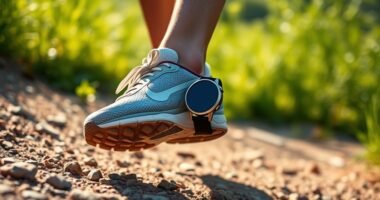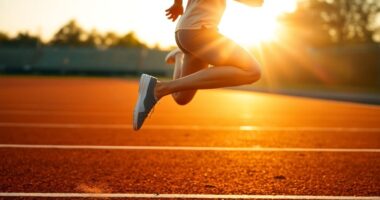To find your sweet spot, focus on balancing stride length and cadence, which directly impacts your speed, efficiency, and injury risk. Shortening or lengthening your stride affects energy use and stability, so aim for a natural rhythm with a comfortable stride that minimizes impact. Optimizing your turnover—step rate—helps maintain momentum without overexertion. Keep in mind terrain and footwear also influence this balance. Continue exploring these techniques to unbolt your best running form.
Key Takeaways
- Optimal running efficiency balances stride length and cadence to reduce injury risk and enhance speed.
- Increasing stride length boosts speed but may decrease energy efficiency and stability if overextended.
- Higher turnover (cadence) improves endurance and reduces impact forces with shorter, quicker steps.
- Finding your “sweet spot” involves aligning stride length and cadence with natural biomechanics and rhythm.
- Monitoring and adjusting both factors through video analysis and feedback optimize performance and prevent overuse.
Understanding the Basics of Running Mechanics

Understanding the basics of running mechanics is essential for improving your performance and preventing injuries. Your breathing rhythm plays a key role in maintaining endurance and staying relaxed during runs. Proper breathing helps oxygenate your muscles efficiently, which supports muscle flexibility and reduces stiffness. When your breathing is steady and rhythmic, you conserve energy and stay focused. Additionally, having good muscle flexibility allows your joints and muscles to move freely, improving overall stride efficiency. Tight muscles or restricted movement can lead to inefficient running and increase injury risk. Focus on controlled breathing and regular stretching to enhance your mechanics. Developing mindfulness during your runs can further improve your awareness of your form and breathing patterns. Being mindful of your running form can help you make real-time adjustments for better efficiency. Maintaining a strong core can also significantly impact your stride length and turnover, leading to more effective running. Pay attention to your body positioning to optimize your biomechanics and reduce unnecessary strain. By paying attention to these fundamentals, you’ll create a solid foundation for optimizing your stride length and turnover.
The Role of Stride Length in Running Performance

Your stride length directly influences your running speed and how efficiently you use energy. Longer strides can boost performance but may increase injury risk if not managed properly. Understanding how to optimize stride length helps you run faster, conserve energy, and stay injury-free. Incorporating dynamic communication exercises into your training routine can also improve your awareness of body mechanics and coordination, further enhancing your stride efficiency. Additionally, paying attention to proper footwear and biomechanics can support optimal stride development and reduce strain. Recognizing the role of natural movement patterns in your gait can also contribute to more effective stride adjustments and injury prevention. As advancements in AI entertainment continue to evolve, integrating generative AI tools can provide personalized feedback on your running form and help tailor training plans to optimize your stride and turnover.
Impact on Speed
How much does stride length influence your running speed? It has a direct impact, but it’s also connected to your stride variability and turnover rhythm. Increasing your stride length can boost speed, but only if it remains efficient and synchronized with your natural rhythm. Proper biomechanics are essential to prevent injury and maintain efficiency when adjusting stride length. If your stride becomes too long, you may lose stability or disrupt your turnover rhythm, slowing you down. Conversely, maintaining an ideal stride length allows you to maximize each step’s power without sacrificing cadence. The key is finding a balance that complements your stride variability, ensuring each stride contributes to a consistent, effective speed. Too much emphasis on length alone can hinder performance, so focusing on steady, rhythmic turnover is essential for sustained speed. Incorporating training techniques such as interval runs and cadence drills can help optimize this balance.
Energy Efficiency Effects
Have you ever wondered how stride length affects your running energy? Longer strides can increase speed but may reduce energy conservation, leading to quicker fatigue. Conversely, an ideal stride enhances metabolic efficiency, allowing you to run longer with less effort. Stride length influences how efficiently your body uses energy during each step.
| Stride Length | Energy Effect |
|---|---|
| Shorter | Higher energy expenditure |
| Ideal | Improved metabolic efficiency |
| Longer | Reduced energy conservation |
Choosing a stride that balances length and turnover helps you maximize energy use. When your stride aligns with your body’s natural rhythm, it minimizes unnecessary movements, conserving energy and boosting endurance. Finding this balance is key to maximizing running efficiency.
Injury Prevention Aspects
Choosing an appropriate stride length is crucial for preventing injuries during running. Overextending your stride can lead to increased impact forces, stressing your joints and muscles, raising injury risk. Proper footwear innovations can help absorb shock and support correct biomechanics, reducing strain. Additionally, maintaining effective hydration strategies keeps muscles supple and less prone to cramping or strains caused by improper stride mechanics. A stride that’s too long may cause overstriding, leading to heel strikes that increase stress on your knees and hips. Conversely, a stride that’s too short can cause inefficient running, causing fatigue and injury over time. Finding your sweet spot in stride length minimizes unnecessary impact, supports natural movement, and promotes sustainable running. Prioritizing these factors helps you stay injury-free and enjoy consistent performance.
How Turnover Affects Speed and Endurance
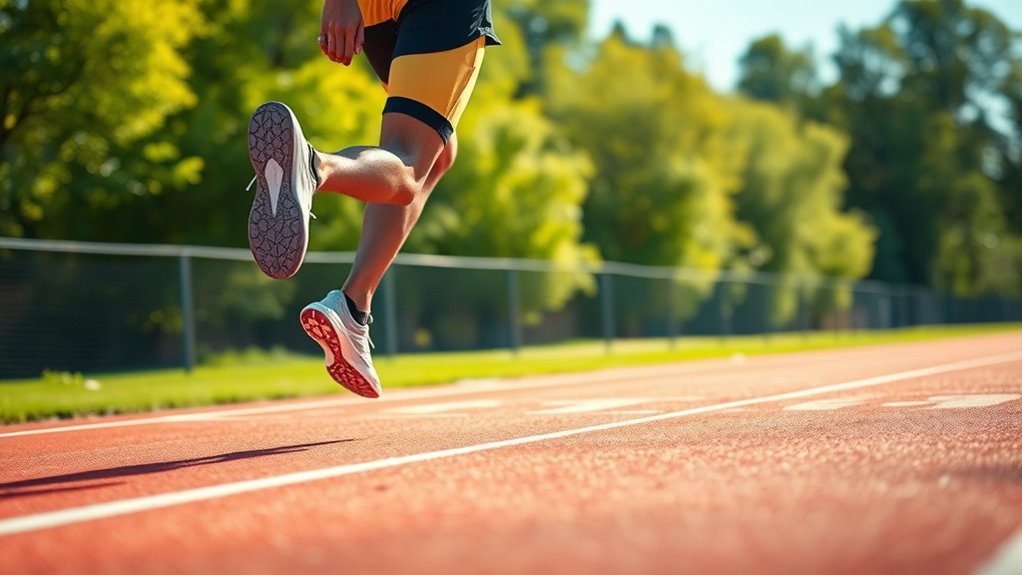
Since increasing your stride turnover means taking more steps per minute, it directly influences your running speed and stamina. A higher cadence variation can help you run faster, but only when paired with proper stride symmetry. When you optimize your turnover, you reduce energy waste and improve endurance. Imagine:
- Your feet striking the ground more quickly and evenly with each step.
- Maintaining consistent rhythm, avoiding awkward cadence fluctuations.
- Your body moving smoothly, conserving energy during long runs.
Focusing on cadence variation helps you find the right pace without overstriding or losing efficiency. This balance allows you to push your limits while preserving stamina. Ultimately, your turnover impacts both speed and endurance—so fine-tuning it can release your full running potential.
The Biomechanics Behind Stride Length and Cadence
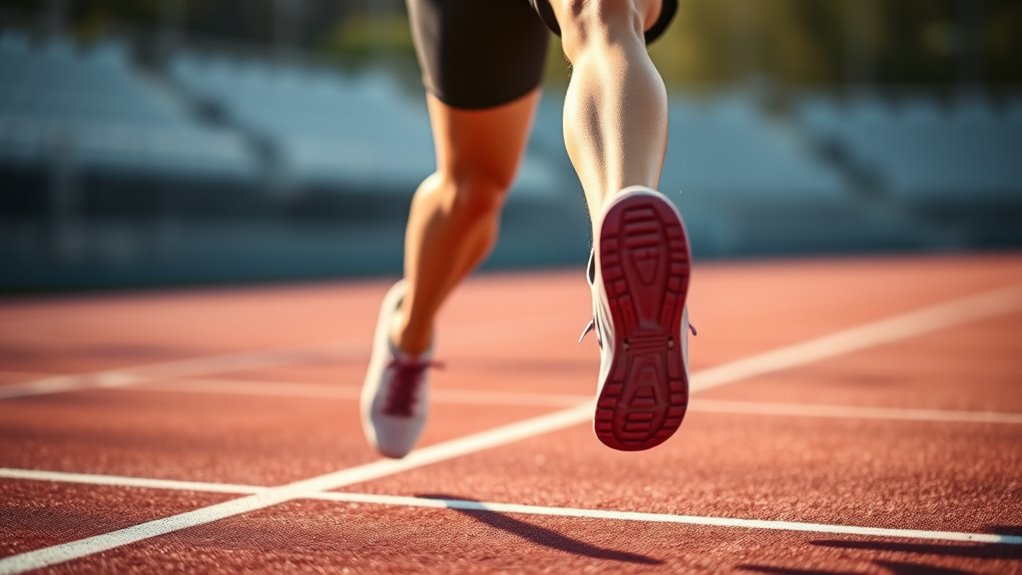
Your stride length and cadence are governed by complex biomechanical processes that determine how efficiently your body moves through space. When your foot strikes the ground, it influences muscle activation patterns, which in turn affect how far you propel yourself with each step. A proper foot strike—whether heel, midfoot, or forefoot—sets the foundation for efficient movement, maximizing energy transfer and reducing injury risk. Muscle activation in your calves, quads, glutes, and core work together to control stride length, balancing force production and absorption. Longer strides require greater muscle engagement and coordination, while higher cadence involves rapid, precise muscle firing. Understanding these biomechanics helps you fine-tune your running form, improving efficiency and finding your optimal stride length and cadence.
Common Mistakes in Balancing Length and Turnover
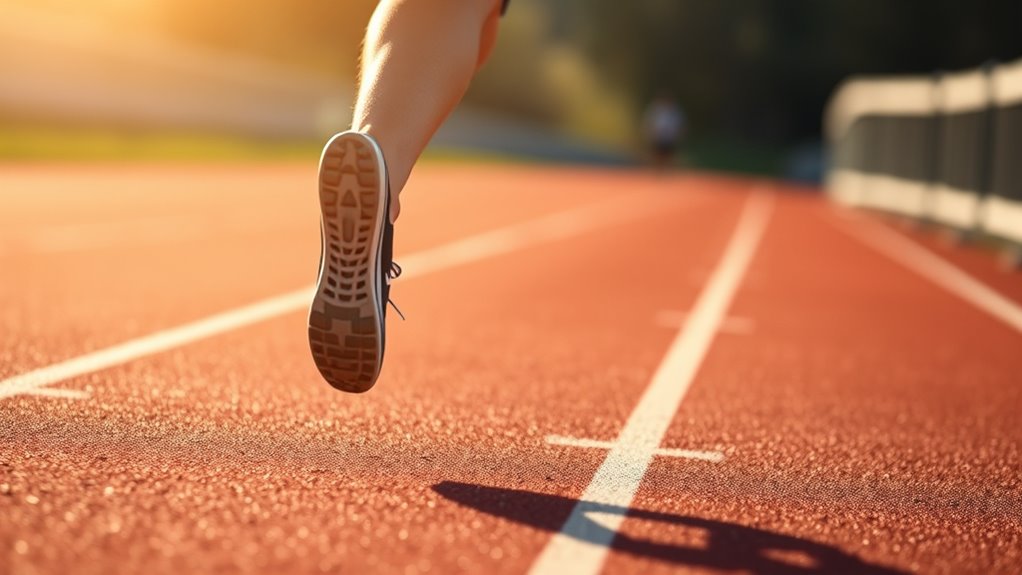
Many runners focus too much on increasing stride length, thinking it will boost speed, but this can lead to inefficiency. You might also neglect maintaining a steady cadence, which disrupts rhythm and wastes energy. Ignoring energy efficiency can cause fatigue and limit your overall progress.
Overemphasizing Stride Length
Focusing too much on increasing stride length can actually hinder your running efficiency. When you chase after stride exaggeration, you risk overlong strides that waste energy and disrupt your rhythm. Overlong strides often lead to a breakdown in proper form, causing you to:
- Land with a heavy heel strike, increasing impact forces
- Overstride, causing your leg to extend ahead of your body and slow you down
- Use excessive muscle effort to propel forward, leading to fatigue
This obsession with length can turn a smooth running gait into a clunky, inefficient stride. Instead of focusing solely on stride length, aim for a balanced approach—maintaining an ideal length that supports your cadence and overall running economy.
Neglecting Cadence Consistency
While it’s tempting to chase a longer stride to boost speed, neglecting your cadence can undermine your progress. Consistent cadence helps maintain stride symmetry, ensuring your running form remains balanced and efficient. When you allow cadence variability to creep in, you risk uneven strides that lead to wasted energy and increased injury risk. Runners often focus on stride length and forget that steady cadence is key to ideal performance. Without maintaining a uniform turnover rate, your muscles and joints don’t work harmoniously, reducing efficiency. To find your sweet spot, monitor your cadence regularly, aiming for a consistent, rhythmic pace. This steadiness enhances stride symmetry and helps you achieve a harmonious balance between stride length and turnover, ultimately improving speed and endurance.
Ignoring Energy Efficiency
Ignoring energy efficiency often leads runners to prioritize either stride length or cadence without considering how their choices impact overall effort. When you focus solely on increasing stride length, you might sacrifice running aerodynamics, making you less aerodynamic and increasing wind resistance. Conversely, overly emphasizing cadence can lead to inefficient energy conservation, causing unnecessary fatigue. Visualize these mistakes:
- You extend your stride, but your arms swing wildly, disrupting your momentum.
- Your cadence spikes, but your posture slouches, wasting energy.
- You push hard, neglecting optimal running aerodynamics, leading to quicker exhaustion.
Balancing stride length and turnover with energy efficiency helps conserve energy and maintain a steady pace. Ignoring this balance prevents you from running smoothly and efficiently, ultimately limiting your endurance and performance.
How to Measure and Analyze Your Running Form
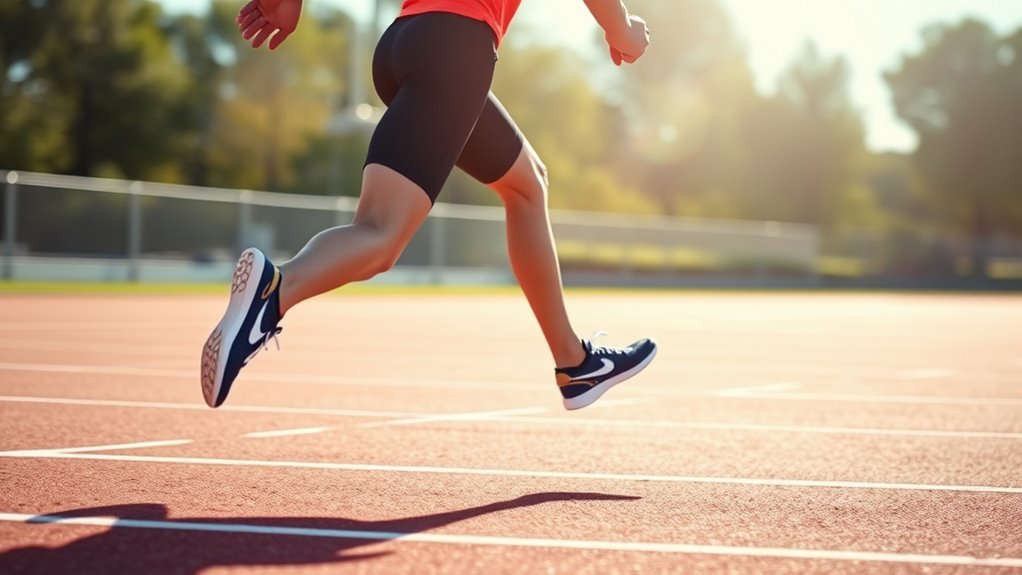
To effectively improve your running form, you need to know how to measure and analyze your stride length and cadence. Start by paying attention to your shoe cushioning; the right shoes can influence your stride comfort and help prevent injuries. Use a stopwatch or a running app to track your steps over a set distance, then divide distance by steps to find your cadence. Observe your running posture: a tall, relaxed posture with minimal vertical movement indicates efficient form. Video recordings can reveal subtle issues in your stride and posture, helping you identify areas for improvement. Regularly evaluating these factors allows you to make targeted adjustments, ensuring your stride length and turnover work together harmoniously for optimal performance and reduced injury risk.
Techniques to Optimize Your Stride and Cadence
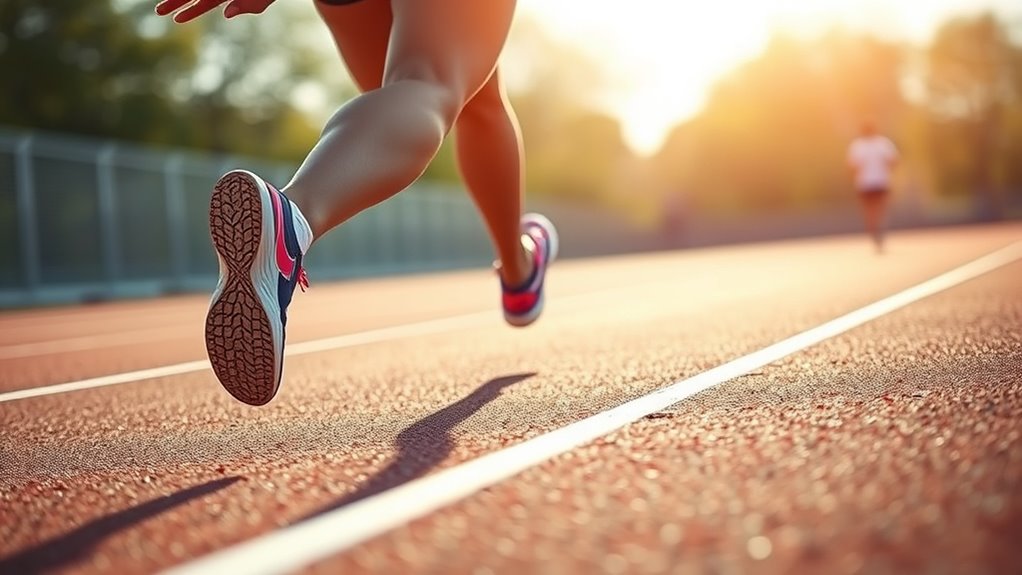
To optimize your stride and cadence, start by adjusting your step length to find a balanced, efficient pace. Increase your cadence gradually to avoid overstriding and reduce injury risk. Focus on improving your running economy to conserve energy and boost overall performance.
Adjust Your Step Length
Adjusting your step length can considerably improve your running efficiency and reduce injury risk. To do this effectively, focus on aligning your running posture and choosing shoe technology that supports proper stride. Here are three ways to optimize your step length:
- Visualize a slight forward lean, keeping your torso upright and engaging your core.
- Use shoes with responsive cushioning to encourage natural foot strike and smooth *progressions*.
- Practice short, controlled steps on a treadmill or soft surface, gradually increasing length without overextending.
Increase Cadence Strategically
Increasing your cadence can markedly enhance running efficiency and help prevent injuries caused by overstriding. To do this, focus on establishing a steady cadence rhythm that feels natural and sustainable. Start by counting your steps per minute during a run, aiming for a modest increase—around 5-10%. Use a metronome or music with a set beat to reinforce your stride consistency. Avoid sudden jumps; instead, gradually adjust your pace over several runs. Pay attention to your body’s feedback, ensuring you’re not overexerting or losing form. Improving cadence isn’t about rushing; it’s about finding a rhythm that maximizes your efficiency while reducing impact forces. Strategic, incremental changes help embed new habits, making your stride more effective and injury-resistant.
Focus on Running Economy
Focusing on running economy means refining your stride and cadence to make each step more efficient. To do this, pay attention to your foot strike patterns and muscle activation. Small adjustments can lead to big improvements.
Imagine:
- Landing softly with a midfoot strike, reducing impact forces.
- Engaging your core and leg muscles to maximize muscle activation with each stride.
- Maintaining a relaxed upper body to conserve energy and promote smooth, efficient movement.
The Impact of Terrain and Footwear on Your Running Style
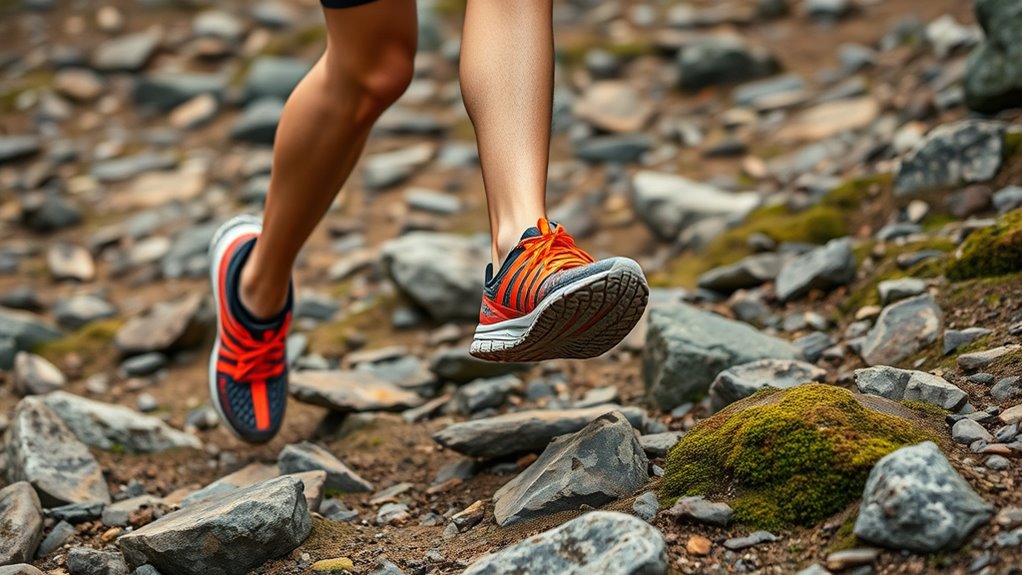
The terrain you run on and the footwear you choose can considerably influence your running style. When tackling trail terrain, you tend to adopt a more cautious stride, with shorter steps and softer landings to navigate uneven surfaces. Your running shoes play a crucial role in this adjustment, providing support and grip.
| Terrain Type | Impact on Running Style |
|---|---|
| Trail | Shorter stride, softer landings |
| Road | Longer stride, faster turnover |
| Track | Balanced stride, consistent pace |
Choosing the right running shoes for each terrain helps optimize your efficiency and reduces injury risk. Recognizing how different surfaces influence your stride allows you to adapt your technique for better performance and comfort.
Training Strategies to Find Your Ideal Balance

To find your ideal balance between stride length and turnover, you need to adopt targeted training strategies that emphasize both aspects. Focus on pacing strategies that help you control your speed and prevent overextending your stride or rushing your steps. Incorporate drills that enhance mental focus, allowing you to stay present and aware of your form during runs. To refine your balance, try:
- Interval Runs — alternate fast and slow segments to improve both stride length and turnover.
- Cadence Drills — use a metronome or music to maintain a consistent step rate.
- Form Focus Sessions — dedicate runs to consciously adjusting your stride and pace, sharpening mental focus for better awareness.
These strategies help you fine-tune your mechanics efficiently.
Signs You’re Running With the Right or Wrong Mechanics
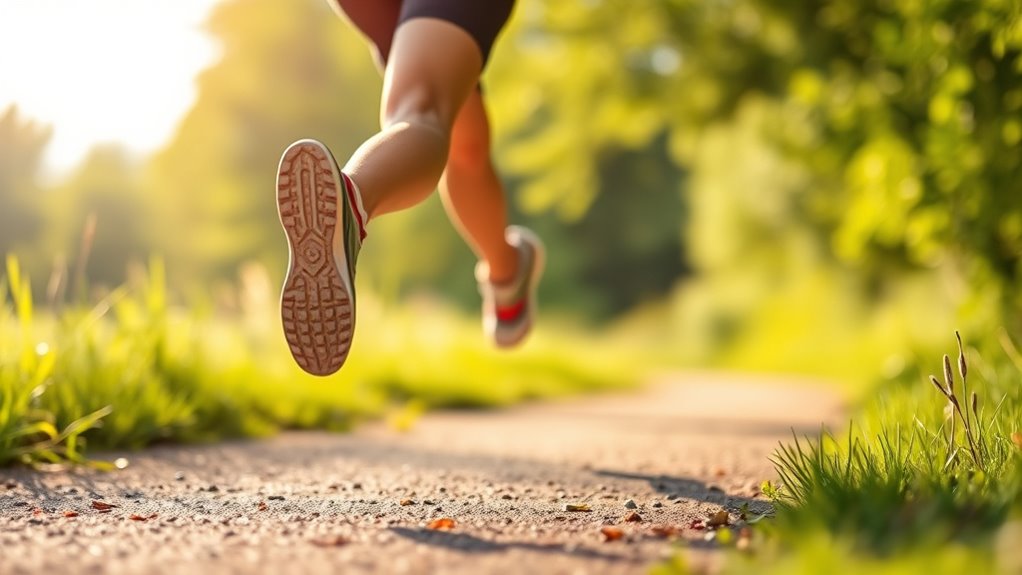
Running with proper mechanics often feels natural, but recognizing the signs can help you identify whether you’re on the right track or need adjustments. If your breath control remains steady and efficient during runs, it indicates good form and proper oxygen flow. Conversely, gasping or irregular breathing suggests your mechanics might be off. Mental focus is also essential; if you feel relaxed and attentive rather than tense or distracted, you’re likely running correctly. Pay attention to your posture, stride, and how your body feels. Pain or excessive fatigue can signal improper technique. When your breathing and mental focus stay consistent, you’re more likely to maintain ideal stride length and turnover, reducing injury risk and improving performance. These signs help you fine-tune your mechanics for better running efficiency.
Frequently Asked Questions
How Do I Determine My Optimal Stride Length for Different Race Distances?
To determine your ideal stride length for different race distances, start with a stride analysis during training runs. Pay attention to your cadence and how your stride feels at various speeds. Adjust your stride to find a balance that maintains efficient pacing without overexerting. Your goal is to develop a pacing strategy that maximizes energy use, helping you conserve effort and improve performance across short and long races.
Can Adjusting Cadence Improve Running Efficiency Without Increasing Injury Risk?
Like a well-tuned engine, your running efficiency can improve with cadence adjustments. When you focus on slight increases in your turnover, you optimize your stride and reduce overstriding, which can lower injury risk. This mindful tweak enhances efficiency without overloading your body. Just as a craftsman refines their work, fine-tuning your cadence helps maintain performance and injury prevention, making each run smoother and safer.
What Role Does Body Type Play in Finding the Right Stride Length and Turnover?
Your body type influences your biomechanics adaptation and is shaped by genetic influences, which affect your ideal stride length and turnover. You might find that taller runners naturally have longer strides, while shorter runners excel with quicker turnover. Understanding your unique biomechanics helps you optimize efficiency and reduce injury risk. By tailoring your running form to these factors, you can improve performance and comfort, making your runs more effective and enjoyable.
How Do Weather Conditions Influence the Ideal Balance Between Stride Length and Cadence?
Weather variability and temperature adjustments considerably impact your running form. In cold weather, you might shorten your stride to conserve warmth and energy, while in heat, increasing cadence helps prevent overheating. Windy conditions may require you to adjust your stride and turnover to maintain efficiency, and wet surfaces demand caution, often prompting shorter strides for stability. Adapting your stride length and cadence based on weather ensures safer, more effective runs.
Are There Specific Drills to Naturally Develop an Optimal Stride and Turnover?
You can develop an ideal stride and turnover through specific drills like cadence drills, which help you find your rhythm. Incorporate drill variations such as high knees, butt kicks, and bounding to improve stride length and efficiency naturally. These exercises boost your coordination and muscle memory, making it easier to maintain the right balance between stride length and cadence during your runs. Consistent practice with these drills enhances your overall running economy.
Conclusion
Finding your perfect stride isn’t just about numbers; it’s about feeling the rhythm that makes running feel effortless. Think of your gait as a dance—balance your length and cadence to reveal your true potential. When you tune into your body’s signals, you’ll discover that the sweet spot isn’t a distant goal but a moment ready to embrace. So, are you ready to run smarter, not harder? Your ideal stride awaits—just take the first step.


